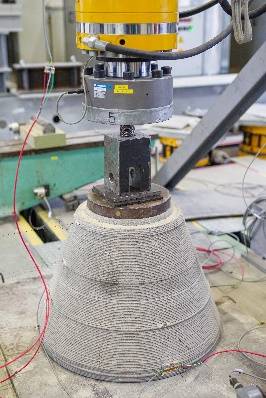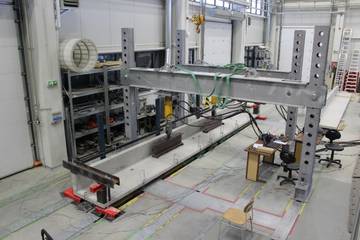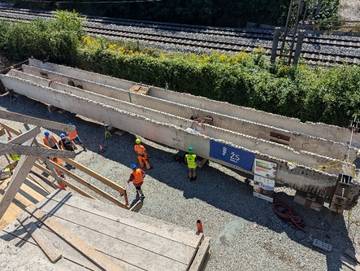Research Groups in
Advanced Civil Engineering Construction and Transportation
Artificial Intelligence and Virtual Reality in Civil Engineering

Leader: doc. Mgr. Tomáš Apeltauer, Ph.D.
The group's activities focus on integrating modern technologies and their application across all areas of the construction industry or civil engineering, particularly in areas of simulation, artificial intelligence (AI), and artificial reality technologies in all their forms (virtual, augmented, and mixed reality).
In the area of modelling and AI, the group concentrates on process automation, the use of machine learning, optimization algorithms, simulation, and generative design. Artificial reality technologies are primarily used as tools for visualization and control of construction projects, as well as for data collection and post-processing in AI-based systems.
The group also applies and offers the application of these technologies in the commercial sphere — for example, for simulating fire, evacuation, or the movement of people in high-traffic buildings, or for converting designed or existing buildings into detailed digital models. These digital models are also used for the visualization, presentation, and management of construction processes in accordance with the BIM methodology.
The group's application-oriented research is aimed at developing effective tools and methodologies that enable not only the practical use of these technologies, but also their continued development, full integration into construction processes, and contribution to related scientific publications.
Geomaterials
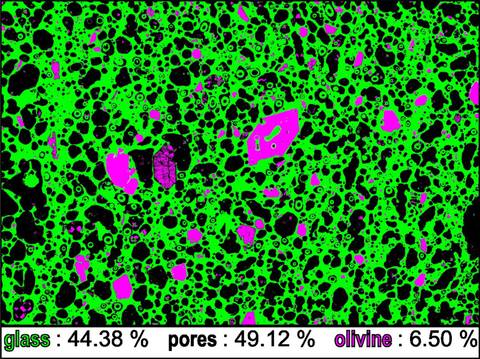
Leader: prof. RNDr. Lukáš Krmíček, Ph.D.
The research group focuses on combined research of mineralogical, geochemical (including radiogenic and non-radiogenic isotopes), physical-mechanical and thermomechanical properties of geomaterials. The study of compositional properties is carried out in cooperation with leading Czech (e.g. Institute of Geology of the Czech Academy of Sciences) and foreign (e.g. GeoForschungsZentrum Potsdam) institutions. The group has its own rock mechanics laboratory. The main testing facility represents the multifunctional Advantest Rock instrument, which was supplied by the Italian company CONTROLS. It consists of two load frames with a capacity of 500 kN and 3000 kN controlled by a servo-hydraulic unit. The second servo-hydraulic unit provides control of the triaxial chamber.
Computational and experimental Geotechnics
Leader: doc. Ing. Lumír Miča, Ph.D.
The research activities of the group are focused on experimental and computer modelling of special foundation elements, development of computational tools, material models of soils/rocks and monitoring of geotechnical structures. Of the special foundation elements, the research group is currently focusing on investigating the behaviour, optimization and design of anchors and piles/energy piles. To investigate the mechanical behaviour of special foundation elements, research is also devoted to the possibility of monitoring them using fibre optic sensors. The transfer function method is implemented to predict their behaviour.
The research group participates in the development of material models for complex and advanced analysis of geotechnical and hydrogeological tasks in connection with building structures in the field of mathematical modelling. Experimental laboratory testing and verification is part of their development.
LNSD – Laboratory for Numerical Structural Design
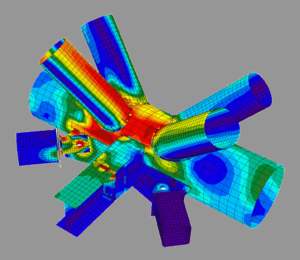
Leader: Ing. Martin Vild, Ph.D.
This research group focuses on advanced design of steel joints and concrete details. Finite Element Method (FEM) modeling has become a common design approach, and the need for standardization has been recognized through the development of the standard prEN 1993-1-14:2024 – Design assisted by finite element analysis.
In collaboration with an industrial partner and international universities, the research group develops and validates advanced design methods for steel joints such as the Component-Based Finite Element Method (CBFEM) and the Compatible Stress Field Method (CSFM) for the design of discontinuity regions in concrete elements. The CBFEM method is available in commercial software such as IDEA StatiCa and Hilti Profis, and has been developed with the support of several projects funded by the Technology Agency of the Czech Republic (TAČR). The method is now officially recognized in the AISC Design Guide 1: Base Connection Design for Steel Structures and is continuously verified through experiments and numerical simulations. Both methods are used worldwide by more than 10,000 customers, who run over a million calculations each month. The research results therefore have an immediate impact on engineering practice.
The research topics include:
- Verification and validation of numerical models of steel and concrete joints, members, and details.
- Evaluation of traditional and advanced design methods through extensive parametric studies using numerically simulated and experimentally validated models.
- Exploration of AI design methods to reduce the scatter of results compared to numerical simulations and experiments, thereby increasing the efficiency of elements while maintaining design reliability.
Additional activities and goals of the group include:
- Industry-supported PhD positions with clear objectives and focus.
- International collaboration in the development of design methods for steel and concrete structures, numerical analysis, and detailing, with the aim of standardization in internationally recognized codes.
Mathematical analysis for the support of solution of engineering problems
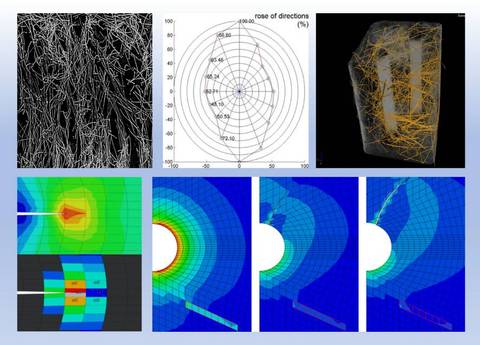
Leader: prof. Ing. Jiří Vala, CSc.
The team pays attention to selected mathematical and computational aspects of solution of engineering problems, namely in the cooperation with other teams and for the support of their research activities. Its scientific focus can be characterized by the following items:
- qualitative properties of solutions of ordinary differential equations, functional equations, functional differential equations, discrete equations, partial differential equations;
- differential forms and their applications in variational calculus and general systems of partial differential equations;
- mathematical statistics, analysis of time series, regressive models, optimisation problems, inverse problems, homogenisation problems for multi-scale formulations;
- numerical methods pro for approximate solution of initial and boundary value problems for both ordinary and partial differential equations, verification of solvability of engineering problems, namely from mechanics of deformable bodies and media;
- projective and differential geometry, systems of computer algebra and computer graphics systems.
Recycled materials for road construction
Leader: prof. Dr. Ing. Michal Varaus
The research group focuses on research into the possibilities of using recycled materials in the construction of road construction layers. These are construction layers for the subbase, base and wearing layers of asphalt layers. The research is carried out in cooperation with Czech and foreign universities (e.g. TU Vienna, TU Braunschweig). An integral part of the research work is also close cooperation with multinational road construction companies (e.g. Skanska a.s.). To evaluate the properties of these materials, modern laboratory equipment is used in the road laboratory of the Faculty of Civil Engineering of the Brno University of Technology, which has a comprehensive set of instruments for empirical and functional tests of asphalt binders (DSR, BBR, RTFOT, PAV), asphalt mixtures (three different devices for determining the stiffness and fatigue characteristics of asphalt mixtures, TSRST) and materials for road construction layers (dynamic triaxial chamber, frost susceptibility).
Computational mechanics of materials and structures
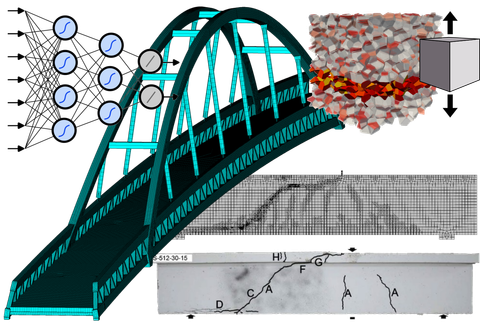
Leader: prof. Ing. Jan Eliáš, Ph.D
Our research activities encompass both fundamental and applied studies on numerical methods for analyzing the mechanical and multiphysical behavior of various physical systems. Our focus ranges from mesoscale modeling of heterogeneous materials to large-scale structural simulations of bridges and power plants. We address both steady-state and transient phenomena in solids and fluids. Our primary research interests include:
- numerical simulation of crack initiation and propagation in quasi-brittle materials such as concrete and ceramics using linear elastic fracture mechanics, cohesive zone models, crack band models, discrete mesoscale models, and related techniques;
- simulations of fatigue deterioration and fatigue crack propagation in homogeneour and heterogeneous materials, high- and low-cycle fatigue;
- homogenization of heterogeneous structures exhibiting inelastic behavior;
- application of machine learning in mechanics, such as automated identification of material parameters and AI-based surrogate modeling of substructure responses;
- analysis of slender structures, including buckling and numerical simulations of stability loss;
- behavior of dissipative nonlinear dynamical systems, including chaotic phenomena and the fractal dimension of fracture surfaces and crack patterns;
- computational fluid dynamics and fluid–structure interaction;
- numerical methods for textile membrane structures, including form-finding and the theory of suspension and cable-supported structures;
- applied research and industrial collaborations for the design and assessment of real-world engineering structures;
- analysis of structural degradation, advanced methods for the assessment of load capacity, damage identification using vibration response;
- development of custom software, whether open-source or proprietary, for mechanical and multiphysical simulations.
Reliability of structures and systems

Leader: prof. Ing. Miroslav Vořechovský, Ph.D.
Our team is dedicated to the development of methodologies that utilize computer models of physical phenomena to study the propagation of uncertainties and imprecisions in input variables through complex transformations. Our work includes input screening, parameter optimization, sensitivity and statistical analyses, and reliability assessments aimed at quantifying the probabilities of rare events. The models we analyze are typically highly computationally demanding. In addition to designing optimal one-shot computer experiments, we also develop adaptively augmented point designs. The overarching goal is to deepen the understanding of how uncertainty propagates from input data to model outcomes.
Our core research activities include:
- systematic development of methods for probabilistic design of concrete structures throughout their life cycle, based on stochastic nonlinear computational mechanics;
- probabilistic aspects of fatigue failure of heterogeneous materials (this topic was awarded by prestigeous ERC grant);
- development of surrogate metamodels, including physics-informed polynomial chaos expansions, artificial neural networks, nearest neighbor approaches, kriging, and radial basis functions;
- uncertainty quantification of mathematical models, including estimation of probability distribution of quantity of interest;
- global sensitivity analysis, with a focus on quantifying additive and interaction effects in stochastic computational models in structural mechanics;
- solution of inverse problems across the life cycle of engineering structures by combining classical techniques with machine learning methods;
- investigation of statistical size effects, spatial variability of material properties, and the interplay between mechanics and probability theory;
- design of experiments, one-shot desing and adaptive sequential designs, including optimal sampling in design spaces using Monte Carlo methods, quasi-Monte Carlo sequences, Latin hypercube sampling, stratified sampling, asymptotic sampling, and subset simulation;
- dimensionality reduction techniques, both linear and nonlinear;
- development of custom software, either open-source or proprietary, for probability-related tasks.
Experimental analysis and diagnostics of structural elements and structures
Leader: doc. Ing. Petr Daněk, Ph.D.
The working group has long been involved in interdisciplinary activities in fundamental and applied research. It ensures experimental parts of projects in cooperation with materials engineers, structural engineers, and theoretical researchers, with the aim of best predicting the mechanical resistance, durability, service life, and reliability of developed materials and structural systems. An integral part of the work activities is the development of diagnostic methods for assessing the actual conditions of existing structures.
Modern instrumentation is an inseparable and necessary part of effective and comprehensive research and development. The testing laboratories are equipped with mechanical and hydraulic testing equipment with a test range from 30 to 4000 kN, a variable hydraulic loading system and a system for surface loading. An integral part is air-conditioned laboratories and climate chambers for long-term measurement of shrinkage and creep of concrete materials. The workplace also has a wide range of sensors, data acquisition systems and equipment for collecting and evaluating monitored quantities during tests.
For activities focused on diagnostics and verification of existing structures, the workplace uses modern approaches, including a combination of non-destructive, semi-destructive, and destructive methods, with the aim of assessing the condition of the structure in situ as effectively as possible. It has modern ultrasonic devices, ground-penetrating radars, seismographs, and other equipment needed for comprehensive diagnostics of buildings. Specific examples of the group's activities are as follows:
- Experimental analysis of mechanical resistance of building structures and products, field and laboratory,
- Monitoring of structures (during construction, during the life of the structure),
- Evaluation of existing structures with a preference for modern NDT diagnostic methods,
- Experimental analyses of fracture parameters of cement composites,
- Software support for statistical-probability evaluation of experimental analysis and diagnostics data of building structures,
- Laboratory and field tests of rheological properties of concrete structures,
- Experimental methods for complex determination of physical and mechanical properties of building materials, elements and structures concerning durability and sustainability,
- Advanced methods for evaluation of surface properties of materials using deep-learning pixel classification models,
- Evaluation of materials and products in terms of resistance to cracking and propagation,
- Development of the potential for the use of non-destructive methods for the evaluation of structural defects and uniformity of building components and elements,
- Dynamic response and fatigue of structures and structural components,
- Development of new methodologies and procedures for sophisticated diagnostics of existing structures with an emphasis on sustainability and maximum reduction of reconstruction costs and extension of the life of existing structures, especially those with significant social importance.
Accessibility of transport structures for people with reduced mobility
Leader: Ing. Richard Svoboda, Ph.D.
The research group focuses on making transport structures accessible to people with reduced mobility, especially both people with visual impairments and people in a wheelchairs.
The research is focused on the area of design, especially the regulatory area with regard to the ability of people with disabilities to use currently used tactile guide paths, but also on modifying structures so that independent movement of people with disabilities is possible.
Another goal is to make transport structures accessible using modern technologies, especially for people with visual impairments. This concerns the possibilities of navigation for blind people using navigation points and current tactile guide paths.
The research group cooperates with the Czech Railway Administration, which is interested in making its structures accessible, and in particular with organizations dealing with assistance to people with reduced mobility, e.g. SONS.
Diagnostics and monitoring of railway structures
Leader: doc. Ing. Otto Plášek, Ph.D.
Research activities in the field of diagnostics of railway structures include measurement and evaluation of the condition of the track structure and its parameters, both short-term and long-term monitoring. The activity is directed towards the application of advanced measurement and evaluation methods, digitisation of the process using artificial intelligence and machine learning algorithms. Specifically, these activities are aimed at:
- measurement of track geometric parameters, monitoring the development of the track quality, identification of local defects,
- development of diagnostic systems for evaluation of the technical state of switches and crossings,
- evaluation of rail microgeometry, i.e. wear of rails, development of rail corrugation on the running surface and evaluation of its roughness,
- measurement and analysis of noise and vibration from railway traffic, identification of acoustic-vibration parameters of railway structures,
- evaluation of stability of continuous welded rail, measurement and evaluation of lateral resistance of sleepers and bearers,
- static and impact load tests of track substructure.
Research and development is carried out in the field of railway and tramway lines.
prof. Ing.
Pavel
Schmid
Ph.D.
Research Theme Coordinator Advanced Civil Engineering Construction and Transportation
